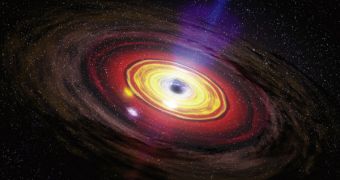Black holes and space-time singularities have played a hugely important role in explaining some of astronomy's greatest mysteries, but also in popular science-fiction entertainment shows and books. However, the newest model of the Universe, developed by a Nobel Prize-winning scientist, has no room at all for this type of structures. In short, the new theory states that, in order for other things to be explained, these two phenomena must not exist, Technology Review reports.
The new model arose from a need to unite our knowledge of the large-scale world with that of the small-scale interactions between particles. Essentially, for a long time, physicists have been on a path to unite Albert Einstein's Theory of General Relativity with quantum mechanics, a theory that explains how subatomic particles interact. One of the most promising methods that could allow for that in the future is known as the string theory, a set of ideas derived from quantum physics. The string theory no longer keep track of the established cause-effect implication.
This means that it provides an emergent explanation for gravity, as in the phenomenon spawns from the complexion in the strings. This means that physicist Gerard 't Hooft's theory has only mildly to do with the cause-effect principle, and this means that a new kind of symmetry needs to be established for the entire Universe. Once this is done, some interesting side-effects appear. The expert argues that, in order to keep the idea of causality in a theory of quantum gravity, we need to accept the idea of a symmetry of scale. This, in fact, means that the laws of physics, for example, are the same at every scale.
Hooft also introduces the idea of “black hole complementarity,” which essentially states that an independent observer, located inside a black hole, views the Universe significantly different from an observer outside the black hole. “If we add these to our set of symmetry transformations, black holes, space-time singularities, and horizons disappear,” the physicist says. He admits, however, that there are still some modifications to be made on his theory. The expert says that the constant G (gravity) Newton proposed is not scale-invariant, meaning its effects are different depending on scale.
Still, Hooft says, there is no difference between large- and small-scale physics. He argues that the differences we are seeing could be the product of other factors that break the symmetry, and generate an illusion of sorts. This illusion may be what drives us to perceive different effects of various agents depending on scale. If this idea is true, then uniting the two theories may become unnecessary at all.

 14 DAY TRIAL //
14 DAY TRIAL //